|
HAVERSTRAW
BRICKYARD OWNERS & OPERATORS |
LANDSLIDE! |
HAVERSTRAW BRICKYARDS TODAY
A major center for the industry was Haverstraw (in Rockland County, NY) located at the widest point on the river, where prime raw material in the rich, blue clay, and a skilled local workforce combined to make the area "the Brickmaking Capital of the World," as it had been called.

(postcard source: New City, NY Library)
Starting in 1771 the area along the river was used for brick making by Jacob Van Dyke from Holland. He made bricks by hand which were used for fireplaces and chimneys.
In 1815 James Wood, an Englishman, came to Haverstraw and established his first brickyard.
The industry grew quickly. In about 1850, James Eckerson constructed one of the largest brick plants along the Hudson River in Haverstraw.
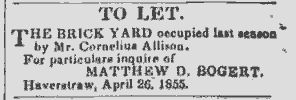
from the Rockland County Messenger, June 28, 1855
In 1853 there was a yard operated by George S. Wood in Grassy Point (just north of Haverstraw). In 1855, a yard in Haverstraw was operated by Peck & Briggs. (Source: Rockland County Messenger, New City Library Archives)
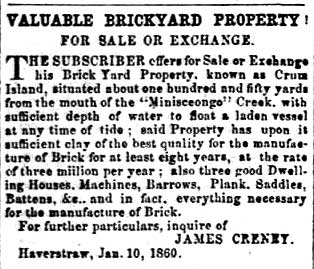
from the Rockland County Messenger, April 26, 1860
In 1863, a schooner (sailboat, wind-driven) named E. Washburn was launched - it carried 60,000 bricks, which was enough for a moderate-sized house. Steam-powered vessels took over about 1880.

Haverstraw's brickyards in the Spring of 1905
SOURCE: Daniel deNoyelles "Within These Gates"
By 1883 there were 41 brickyards and over a century of manufacturing. 148 brands were moulded in the vicinity. In North Rockland alone, the business employed some 2500 men in the brick plants, and 10,000 men, women and children were supported by the industry.
In a single year 300,000,000 bricks were shipped out of the Haverstraw Bay area for the NY metropolitan markets, which at times were using over a billion bricks annually.
Haverstraw's Place in History Assured by Machine
|
By SUZAN CLARKE
THE JOURNAL NEWS
(Original publication: March 28, 2003)
(used with permission from the publisher)
At the height of its prosperity, Haverstraw village was part of a bustling region regarded worldwide as a premier brickmaking area.
Ten thousand people in the area depended upon the bay-area industry for their livelihood. Outsiders flocked to the village, which was a thriving metropolis for more than 100 years.
Though Haverstraw dates back to 1712, it gained prominence when its brickyards began operating in the late 1700s
Brickmakers were confounded by the problems they encountered in the oftentimes irregular shape of the building blocks, which at that time were made almost entirely by hand.
A few rudimentary tools had been introduced to help streamline production, but it wasn't until 1852, when Richard VerValen developed his brickmaking machine, that the industry exploded.
"It had a tremendous impact because prior to that everything was done by hand," said Haverstraw Village Mayor Francis "Bud" Wassmer. "This really increased productivity substantially." VerValen, who knew the industry and had "an inventive mind," pondered the dilemma for a time, according to the late historian, author and area resident, Daniel deNoyelles, in his book, "Within These Gates."
A Closter, N.J., native, VerValen had lived in Rockland as a child, then left for upstate New York before returning to Haverstraw in 1848, where he worked manufacturing stoves and plows in his foundry, the book said.
According to legend, deNoyelles wrote, it was in the middle of a Sunday church sermon that VerValen had a breakthrough.
VerValen patented his machine in 1852 and, deNoyelles said, its principles were "so workable and so novel to brickmaking" that they were used until a more advanced machine, incorporating some of his original ideas, was developed in the 1920s.
So successful was his machine that patent holders of other models sued VerValen, who was awarded the right to call himself the machine's originator after carefully explaining his principles. The cases against him were dropped, deNoyelles wrote.
"That machine allowed them to increase the production, oh, I don't know, 10-fold, 20-fold," said Tom Sullivan, a local history buff.
Demand had been on the upswing since a terrible fire in 1835 in New York City's financial district destroyed 13 acres of buildings.The tremendous need for materials to rebuild and to accommodate the city's growing immigrant population gave impetus to the growth of the north Rockland brickmaking industry.
The VerValen machine revolutionized the way bricks were made. Rather than have workers pour the clay into molds by hand, the machine automated the molding process, allowing a stiffer clay mixture to be used. The result was a more uniformly shaped brick.
VerValen's invention so improved the brickmaking process that he quickly got 150 orders from operators in the area.
Wassmer said the machine changed the face of the industry, and of the area. It set Haverstraw on a path of prosperity that would last for 75 years. "Haverstraw made brick before that, but what the machine did was give the brick companies the ability to make millions of brick instead of tens of thousands," he said.
Business flourished, and at one point 42 yards operated in the area, turning out 148 brands and supporting about 2,500 employees and their families. Those bricks were used to build a variety of structures, including most of the New York City tenements.
The bay areas of Haverstraw, Grassy Point, Garnerville, Stony Point, Tomkins Cove and Jones Point, as well as Tappan and Thiells, all had their own brickyards. But about one-third of production in the area came from Haverstraw, Sullivan said.
Haverstraw's location at the widest point on the river, with prime raw material in the rich, blue clay, and the talent in the industry combined to make the area the brickmaking capital of the world, as it had been called.
But things gradually changed and the industry declined.
Careless excavation of Haverstraw's clay deposits so weakened the soil that it gave way on Jan. 8, 1906, killing 19 as it buried five streets and 21 buildings. Some charged greedy brickmakers with undermining the land and ignoring signs of its instability.
Then, shortly after the turn of the 20th century, things began to change. Cheaper European bricks flooded the market, and the focus shifted to lighter building materials such as aluminum and steel. The Great Depression sounded the industry's death knell, and World War II delivered the final blow.
When the last yard, Rockland Brick Co., dismantled its only remaining kiln shed in 1941, part of the shed was delivered to a World War II munitions plant for scrap.
But Wassmer said the village's rich heritage would play a part in its economic rebirth. Pointing to the fact that heritage tourism is on the rise in New York state, he said Haverstraw's legacy would attract visitors who, interested in its past, would contribute to its renaissance.
Joan Talamini, who recently visited the Haverstraw Brick Museum in the village, said it was important to preserve aspects of the past before they were completely lost.
She noted that historic homes in the area had been razed to make way for newer residential and commercial developments, but said progress must not come at the price of losing touch with one's heritage.
"We have lost all those things, and now people would like to have it back," she said. "We lost a great deal of history."
For her, the museum remains a tangible link to the past, which she visits again and again.
|
For more information on the Innovators and Inventors,
visit
Hudson River Brickmaking.
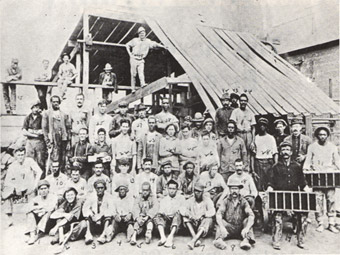
The Malley Brickyard in 1912
(Source: Town of Haverstraw web site)
Brickyard Owners & Operators:
(Compiled from: History of Rockland County, J.B. Beers & Co., 1884;
Within These Gates, Daniel de Noyelles, 1982; "Some of the Yards," Haverstraw Brick Museum)
(maps from F.W. Beers Rockland Cty Atlas, 1891, David Rumsey Collection, Cartography Associates)
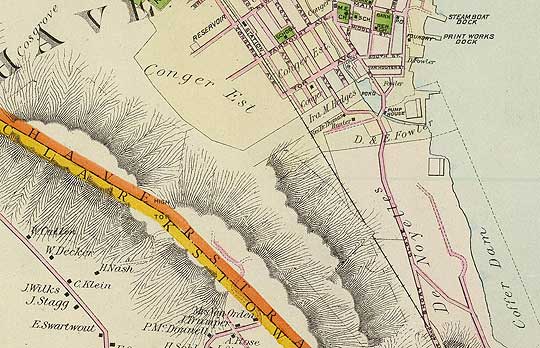
Note the Coffer Dam in the river opposite the Fowler and DeNoyelles yards.
CLICK MAP FOR LARGER VIEW
From bottom of map to top (from South to North)...
YARD# LAND OWNER OPERATORS YEAR
1 Daniel DeNoyelles James Wood 1830s
Thomas Malley 1921
DeNoyelles
2 Daniel DeNoyelles DeBaun & Campelle 1854
Christie & McCabe 1884
Hewey Christie 1887-1896
Matthew Gormley 1903
3 Daniel DeNoyelles Mackey & Lillis 1854
John Shankey & Co. 1884
T. Shankey &
S.L. Carlisle 1887
4 Daniel DeNoyelles J.J McMahon & Co. 1884
Patrick Lynch 1887-1896
Lynch Brothers 1903
Daniel DeNoyelles 1931
DeNoyelles & Carroll 1940-1941
5 Denton, Fowler & Denton Fowler 1887-1896
Son Denton Fowler & Son 1903
|

CLICK MAP FOR LARGER VIEW
From bottom of map to top (from South to North)...
YARD# LAND OWNER OPERATORS YEAR
6 John Ferndon John Ferndon 1854
John Derbyshire John Derbyshire 1884
Excelsior Brick Co Excelsior Brick Co. 1896-1935
7 J.P. Hunter J.P. Hunter 1854
Theodore Frederick Theodore Frederick 1876
Gillies & Frederick(s)Gillies & Frederick 1884
A. Donnelly & Son 1896
Nicholson & Reilly 1903
Estate of Wm. Bennett Estate of Wm. Bennett 1910
8 James Eckerson Fowler 1854
Patrick Buckley 1883
Andrew Donnelly 1887
Nickerson & Reilly 1896
9 James Eckerson J.G. Eckerson 1887
Matthew Gormley 1897
G.S. Sherwood, Renn 1896
Nicholson & Son 1903
Thos. Tanney and
E.N. Renn 1910
10 Estate of M.A. Archer M.A. Archer 1887
Phillip Goldrick 1896
C.D.& G. Archer 1910
11 J.E. Eckerson J.E. Eckerson 1884
P. Goldrick 1896
O'Brien & Lynch 1910
12 Mrs. E. Snedeker Snedeker 1854
Snedeker Bros. 1884-1920
13 Estate of John Peck Gordon& Theodore Peck 1896
Shankey & Morrison 1910
Edward N. Renn 1920
14 Estate of John Peck Peck & Briggs 1854
T.G. Peck & Co. 1884
Theodore J. Peck & Co 1898
G. Peck 1910
15 Estate of M.A. Archer M.A. Archer 1887
Archer Bros. 1896
Edward N. Renn 1903
C.D.& G. Archer 1910-1930
16 George S. Allison Brewster J. Allison 1884-1910
B.J. Allison
Morrisey & Co. Morrisey & Co. 1920-1930s
|

CLICK MAP FOR LARGER VIEW
From bottom of map to top (from South to North)...
YARD# LAND OWNER OPERATORS YEAR
17 Haverstraw Brick John Oldfield 1884
& Clay Brockway & Smith 1884
Rowan & Scott 1896
Garner Brick Co. 1903
Garner Brick Works 1920-1920s
18 George S. Allison Wood & Keenan 1884
Allison & Wood 1896-1910
J.J. Byrnes & Sons 1921
19 George S. Allison Wood & Allison 1898
Keenan 1884
Allison & Wood 1896-1910
20 Mrs. E.G. Reid and Diamond Brick Co. 1884
Haverstraw Brick Cahill & Carroll 1896
& Clay Morrissey & Co. 1910-1920s
Hudson River Brick Co Hudson River Brick Co 1930
21 Mrs. E.G. Reid and Diamond Brick Co. 1884
Haverstraw Brick Washburn & Fowler 1896-1903
& Clay Denton Fowler Jr & Co 1910-1920
Hudson River Brick Co Hudson River Brick Co 1930
22 Mrs. E.G. Reid and Diamond Brick Co. 1884
Haverstraw Brick Sliney & Heidlinger 1896
& Clay Frank Grimes,
Hudson River Brick Co Heidlinger & Rose 1903
Terrence McGuire 1898
Brophy & Morrissey
John Lynch 1910
Pat McGuire
Ramapo Brick Co. 1921
23 Fowler & Washburn Fowler & Co. 1884
Washburn-Worral &
Palmer
Worral & Byrnes 1898
Richard Crowley 1887
Washburn Brothers 1896
Lucian H. Washburn 1903
24 Fowler & Washburn Uriah F. Washburn 1910
|

CLICK MAP FOR LARGER VIEW
From bottom of map to top (from South to North)...
YARD# LAND OWNER OPERATORS YEAR
25 D. Tomkins & Sons Reilly & Clark 1884-1905
26 D. Tomkins & Sons Reilly & Clark 1890-1910
27 D. Tomkins & Sons Thos. Reilly & Marks 1910
28 D. Tomkins & Sons Tomkins Bros. 1884
Reilly & Rose 1884-1903
Reilly & Marks 1910
29 D. Tomkins & Sons Acme Brick Co. 1896
Watson Tomkins
30 Washburn, Worrall
& Palmer Carr & Smith 1884
31 Adam Lillburn Adam Lillburn 1887
Thos. Malley 1896
32 Haverstraw Clay George Knapp 1851-1885
& Brick Felter Brothers 1880
Patrick Brophy 1886
Brophy Brothers 1910
33 Haverstraw Clay Garret Allison 1884
& Brick Reilly & Farley 1887
Patrick Brophy 1903
34 F. & J. Felter James Morrissey 1884-1905
35 Thos. Shankey & Son 1903
36 Fowler & Washburn Washburn & Fowler 1884
37 Adam Lillburn Adam Lillburn 1880
Ohler & Brennan 1887
Freeman & McGuire
McGowan & McGovern 1894
Hurley & Brophy 1896
38 Adam Lillburn Adam Lillburn 1880
Malley & Goldrick 1884
Johnson & Meyers 1887
Clark & Goldrick
Frank L. Dunnigan 1921
39 Adam Lillburn Malley & Goldrick 1884
40 Mrs. R.C. Lillburn Burns-Goldsmith-Barns 1876
41 David Munn David Munn 1838
Tomas Doyle 1849
|
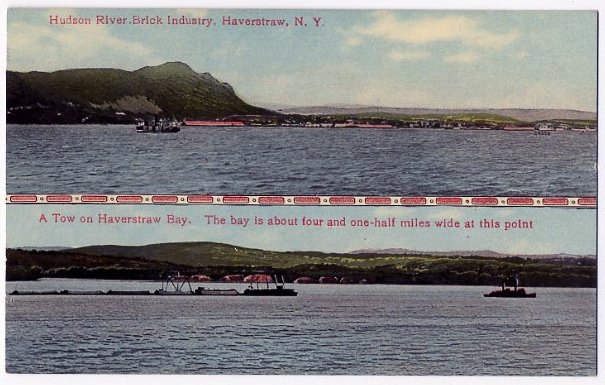
(postcard source: New City, NY Library)
Brick Manufacturers
in the Haverstraw District in 1910:
Source: "Within These Gates" by Daniel deNoyelles
Name of Company Number of Machines
B. J. Allison & Co., Haverstraw, NY ...................... 7
Wood & Allison, Haverstraw, NY ........................... 4
U. F. Washburn & Co., Haverstraw, NY .................... 11
L. H. Washburn, Haverstraw, NY ........................... 2
Washburn & Fowler, Haverstraw, NY ........................ 3
Garner Brick Works, Haverstraw, NY ....................... 6
Malley Brick Co., Haverstraw, NY ......................... 7
Excelsior Brick Co., Haverstraw, NY ...................... 7
DeNoyelles Brick Co., Haverstraw, NY .................... 13
Everett Fowler, Haverstraw, NY ........................... 4
D. Fowler Jr. & Co., Haverstraw, NY ...................... 5
Peck Brick Co., Haverstraw, NY ........................... 6
C. & G. A. Archer, Haverstraw, NY ........................ 2
T. McGuire & Son, Haverstraw, NY ......................... 4
Lynch Bros., Haverstraw, NY .............................. 4
Lynch & O'Brien, Haverstraw, NY .......................... 2
E. N. Renn & Co., Haverstraw, NY ......................... 4
J. Nicholson, Haverstraw, NY ............................. 2
James Byrnes, Haverstraw, NY ............................. 2
Dunnigan, Mrs. F. L., Haverstraw, NY ..................... 3
Bennett, Mrs. William & Sons, Haverstraw, N.Y. ........... 4
T. Shankey & Son, Haverstraw, NY ......................... 4
Snedeker Bros., Haverstraw, NY ........................... 2
Reilly & Tanney, Haverstraw, NY .......................... 2
Tanney & Coyne, Haverstraw, NY ........................... 2
T. Tanney, Haverstraw, NY ................................ 4
Morrissey & Co., Haverstraw, NY .......................... 5
Fowler & Son, Haverstraw, NY ............................. 6
Shankey & Morrissey, Haverstraw, NY ...................... 4
Archer Yard No. 2, Haverstraw, NY ........................ 4
Brophy & Morrissey, Haverstraw, NY ....................... 4
Riley & Rose, Haverstraw, NY ............................. 3
Riley & Marks, Haverstraw, NY ............................ 4
F. Brophy & Brother, Haverstraw, NY ...................... 3
|
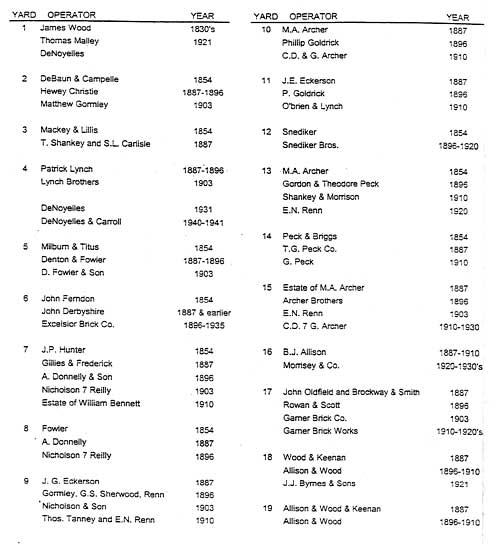

(Source: Haverstraw Brick Museum)
Landslide!
On January 8th, 1906 a landslide occurred in Haverstraw, NY when clay beneath a 100 foot embankment slipped away. This was caused by the gradual weakening of the earth as the excavation of clay deposits moved in from the river toward residential areas.
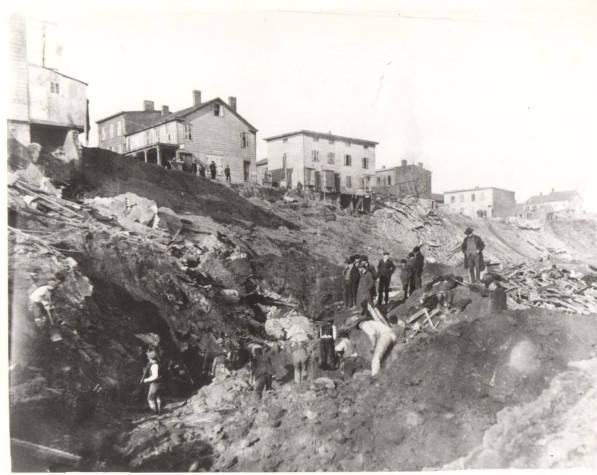
It is believed these images were taken the next day after the landslide, and the men are searching for survivors/victims.
(PHOTO SOURCE: The Historical Society of Rockland County)
It started when a crack on Rockland Street widened and the earth gave way. Fires from the stoves that heated the homes and the kerosene lamps that lit them were knocked over, setting buildings ablaze. Fire hydrants froze in the cold temperatures, and several water mains broke, lowering the pressure and making firefighting ineffective. A snowstorm had coated building roofs, and experts said that prevented the entire village from burning. The landslide left a gaping pit about 150 feet deep which claimed five streets and two avenues from Allison to Jefferson, about a third of the village at that time.
A total of 21 buildings were lost as well as the lives of 4 firefighters and 15 residents. Some charged greedy brickmakers with undermining the land and ignoring signs of its instability.
Compare an 1891 map with a recent satellite view to see the areas and streets that were lost.
Special to The New York Times.
January 9, 1906, Wednesday
22 DIE IN LANDSLIDE; MORE HOUSES IN PERIL; Haverstraw Residences and Occupants Engulfed in Great Pit. BRICKMAKERS WILL PROFIT Disaster Laid to Their Encroachments and $200,000 Worth of Clay Dumped on Their Property.
Read the full article HERE
From "THE PICTURESQUE HUDSON" by Clifton Johnson,
The MacMillan Company, New York, 1915:
At the edge of the Haverstraw shore, for fully two miles, there is an
almost continuous row of rough, wide-spreading sheds used by the brickmakers,
and from many of them the smoke was lazily rising. On their landward side
the clay sediment, which had been deposited in this nook in the bygone time
when the stream was wider and deeper than now, has been removed leaving a
vast hollow. The workers even build coffer dams out into the river to rescue
the valuable brick clay. Much more than half of all the brick made along the
whole course of the river comes from here.
The clay has been excavated in places till the buildings
of the town are close to the precipitous bank, and their
situation seems in some instances decidedly perilous.

(PHOTO SOURCE: Haverstraw Brick Museum)
One autumn afternoon a few years ago a Haverstraw policeman
noticed that the walls of a brick building near the edge
of an excavation were cracking, and he saw a loosened
brick fall out. He went to the owner of the property and
told him there was going to be a landslide; and as the clay
there had been taken out to a depth of one hundred and eighty
feet the prospect was quite disturbing.
Warning was given to the families that lived in the threatened
neighborhood, but they had dwelt so long in the vicinity of
the danger that they thought the alarm needless and went to
bed as usual.
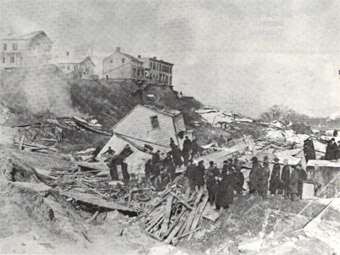
About midnight, however, the clay bank gave way
carrying down houses and people into the frightful chasm.
Rescuers were soon on hand, and they were busy amidst the
debris when there was a second slide that overwhelmed
everyone in its path. The wreckage caught on fire, and the
scene of devastation was brightly lighted. About a dozen
houses had gone down into the depths and a score of lives
were lost. Among those who perished were a father and
mother. When the first houses slid into the chasm theirs
hung on the verge and they had time to take their children
to a point of safety. That done they went back to get their
bank book. They were never seen afterward and not even their
bodies were recovered.
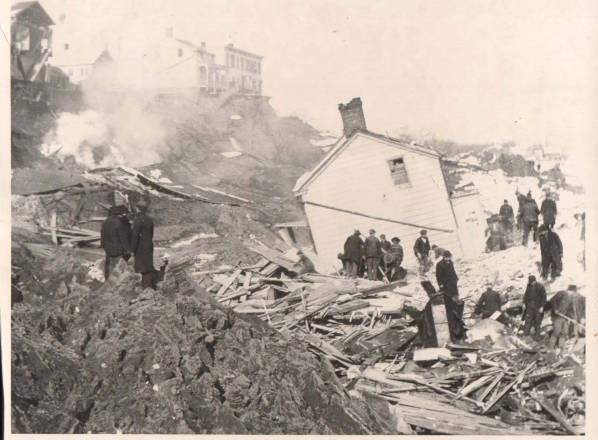
It is believed these images were taken the next day after the landslide, and the men are searching for survivors/victims.
(PHOTO SOURCE: The Historical Society of Rockland County)
The Journal News has a great article on the event in observance of the 100th anniversary.
A plaque commemorating the event is located on Division Street and the Haverstraw Brick Museum is conducting a fundraising drive to build a new monument.
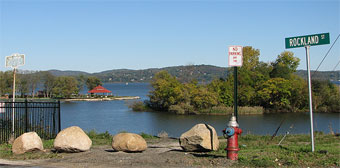
Rockland St. landslide site today
(NY State historic marker sign is on left)
(Click pic for a larger view.)
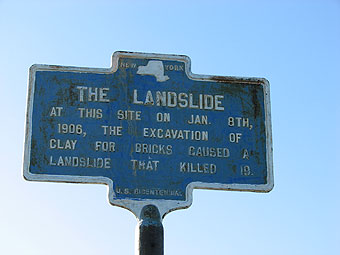
Landslide Historic Marker Sign
The Haverstraw Brick Museum has a wonderful animated diorama that shows exactly how the Great Landslide took place.
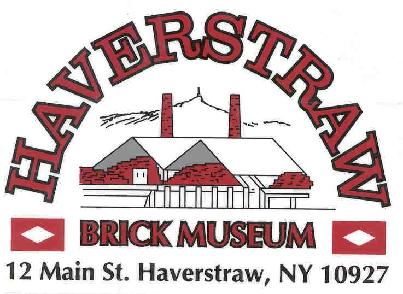
N Y Times article on the Haverstraw Brick Museum
The Haverstraw Brickyards Today
Remnants of the great Haverstraw brickmaking industry are scattered among beautiful parkland all along the Hudson shore. At 21 Gagan Road is Haverstraw Bay Park featuring an open air pavilion, paved walking trails, 3 fishing piers, a boat launch, children's playground and Rockland County's September 11th Memorial and Patriot Garden. At 27 acres, it was Rockland County's first waterfront park.
In the park is the Haverstraw Trophy by artist Michael Morgan with columns made of carved kiln-dried red clay brick. There is also an antique Haverstraw brick path.
Here's a Virtual Tourof the park.
Photos of the park can be seen at MyParkPhotos.com.
And here is a rail track left over from the brickyard days.
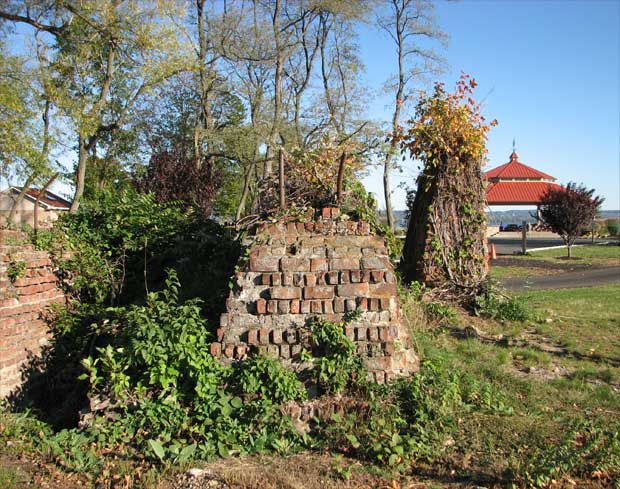
Brickyard Ruins in Bowline Park
Other parks on former brickyard land include Bowline Park off Samsondale Ave. which has an Olympic-sized swimming pool, walking paths and a fishing pier with a spectacular river view.
Nearby is Haverstraw Beach, originally known as Snedeker's Landing, the oldest shipyard in Rockland County. It built barges to ferry brick from the nearby brickyards in Haverstraw to New York City. And here, in 1780, American General Benedict Arnold and the British spy John André exchanged the plans to West Point.
Search This Site For Brick Info:
|
To search the page you are on, Hit CTRL-F
|
|






















